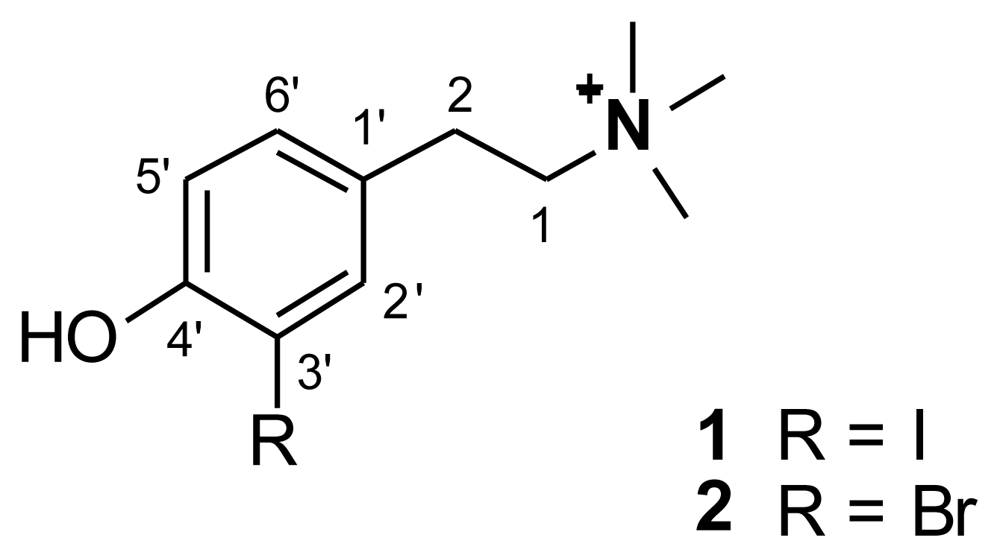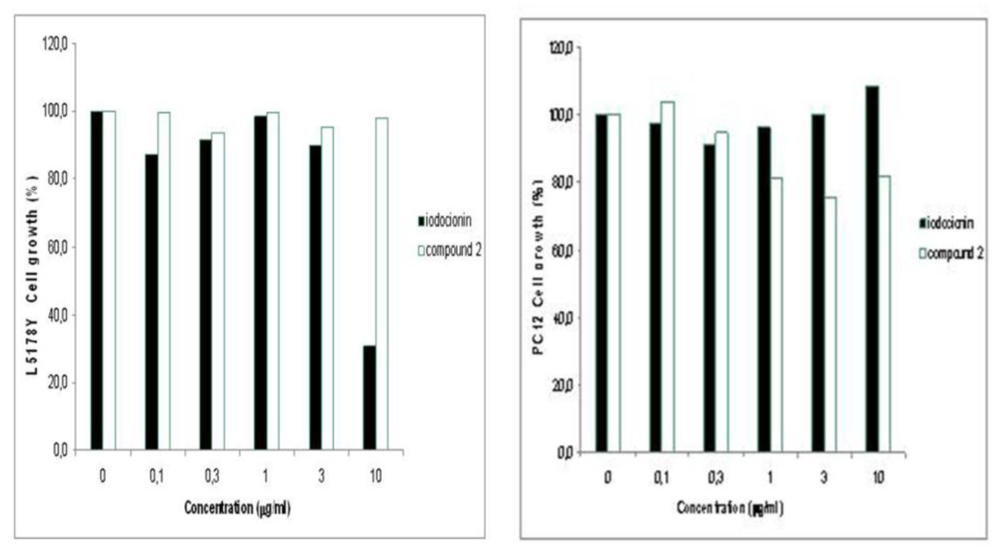Iodocionin, a Cytotoxic Iodinated Metabolite from the Mediterranean Ascidian Ciona edwardsii
Abstract
:1. Introduction
2. Results and Discussion
2.1. Isolation and structure elucidation
2.2. Biological activities of compounds 1 and 2
3. Experimental Section
3.1. General Experimental Procedures
3.2. Extraction and Isolation
Iodocionin (1)
3.3. Cytotoxicity Assays
4. Conclusions
Acknowledgements
- Samples Availability: Available from the authors.
References and Notes
- Gribble, GW. The diversity of naturally produced organohalogens. Chemosphere 2003, 52, 289–297. [Google Scholar]
- Paul, VJ. Chemical defenses of benthic marine invertebrates. In Ecological Roles of Marine Natural Products; Cornell University Press: London, UK, 1992; pp. 164–181. [Google Scholar]
- Albrizio, S; Ciminiello, P; Fattorusso, E; Magno, S; Pansini, M. Chemistry of Verongida sponges, I. Constituents of the Caribbean sponge Pseudoceratina crassa. Tetrahedron 1994, 50, 783–788. [Google Scholar]
- Ciminiello, P; Fattorusso, E; Magno, S; Pansini, M. Chemistry of Verongida sponges, III. Constituents of the Caribbean Verongula sp. J Nat Prod 1994, 57, 1564–1569. [Google Scholar]
- Ciminiello, P; Costantino, V; Fattorusso, E; Magno, S; Mangoni, A; Pansini, M. Chemistry of Verongida Sponges, II. Constituents of the Caribbean Sponge Aplysina fistularis forma fulva. J Nat Prod 1994, 57, 705–712. [Google Scholar]
- Costantino, V; Fattorusso, E; Mangoni, A; Pansini, M. Three new brominated and iodinated tyrosine derivatives from Iotrochota birotulata, a non-Verongida sponge. J Nat Prod 1994, 57, 1552–1556. [Google Scholar]
- Neidleman, SL; Geigert, J. Halometabolites and their sources. In Biohalogenation: Principles, Basic Roles, and Applications; Ellis Horwood, Ltd.: Chichester, UK, 1986; pp. 13–45. [Google Scholar]
- Ciminiello, P; Dell’Aversano, C; Fattorusso, E; Magno, S; Pansini, M. Chemistry of Verongida Sponges. 10. Secondary metabolite composition of the Caribbean Sponge Verongula gigantea. J Nat Prod 2000, 63, 263–266. [Google Scholar]
- Hansen, PE. Carbon-13 NMR of polycyclic aromatic compounds. Org Magn Reson 1979, 12, 109–142. [Google Scholar]
- Sachs, L. Angewandte Statistik Anwendung statistischer Methoden; Springer-Verlag: Berlin, Germany, 1984; p. 242. [Google Scholar]
- Müller, WEG; Zahn, RK. Metabolism of 1-β-d-arabinofuranosyluracil in mouse L5178Y cells. Cancer Res 1979, 39, 1102–1107. [Google Scholar]
- Carmichael, J; DeGraff, WG; Gazdar, AF; Minna, JD; Mitchell, JB. Evaluation of a tetrazolium-based semiautomated colorimetric assay: Assessment of radiosensitivity. Cancer Res 1987, 47, 943–946. [Google Scholar]
- Kreuter, MH; Leake, RE; Rinaldi, F; Müller-Klieser, W; Maidhof, A; Müller, WEG; Schröder, HC. Inhibition of intrinsic protein tyrosine kinase activity of EGF-receptor kinase complex from human breast cancer cells by the marine sponge metabolite (+)-aeroplysinin-1. Comp Biochem Physiol 1990, 97B, 151–158. [Google Scholar]
- Xu, J; Kjer, J; Sendker, J; Wray, V; Guan, H; Edrada, RA; Müller, WEG; Bayer, M; Lin, W; Wu, J; Proksch, P. Cytosporones, coumarins, and an alkaloid from the endophytic fungus Pestalotiopsis sp. isolated from the Chinese mangrove plant Rhizophora mucronata. Bioorg Med Chem 2009, 17, 7362–7367. [Google Scholar]
- Neidleman, SL; Geigert, J. The role of halogenating enzymes and halometabolites in the marine environment. In Biohalogenation: Principles, Basic Roles, and Applications; Ellis Horwood, Ltd.: Chichester, UK, 1986; pp. 113–130. [Google Scholar]


| 1 | 2 | |||
|---|---|---|---|---|
| Pos. | δH (mult., J in Hz) | δC | δH (mult., J in Hz) | δC |
| 1′ | - | 129.2 | - | 129.2 |
| 2′ | 7.68 (d, 2.1) | 140.5 | 7.49 (d, 1.5) | 134.6 |
| 3′ | - | 84.7 | - | 111.2 |
| 4′ | - | 157.3 | - | 154.9 |
| 5′ | 6.81 (d, 8.3) | 115.7 | 6.90 (d, 8.1) | 117.7 |
| 6′ | 7.14 (dd, 8.3, 2.1) | 130.9 | 7.15 (dd, 8.1, 1.5) | 130.3 |
| 1 | 3.50 (m) | 68.2 | 3.53 (m) | 68.5 |
| 2 | 3.01 (m) | 28.6 | 3.05 (m) | 29.1 |
| N(CH3)3 | 3.19 (s) | 53.4 | 3.22 (s) | 53.7 |
| C-1′ | C-2′ | C-3′ | C-4′ | C-5′ | C-6′ | |
|---|---|---|---|---|---|---|
| H-2′ | - | - | 3.8 Hz | 8.7 Hz | - | 9.0 Hz |
| H-5′ | 7.5 Hz | −1.0 Hz | 7.5 Hz | 4.4 Hz | - | - |
| H-6′ | - | 7.4 Hz | −1.4 Hz | 7.4 Hz | 1.0 Hz | - |
© 2010 by the authors; licensee Molecular Diversity Preservation International, Basel, Switzerland This article is an open-access article distributed under the terms and conditions of the Creative Commons Attribution license (http://creativecommons.org/licenses/by/3.0/).
Share and Cite
Aiello, A.; Fattorusso, E.; Imperatore, C.; Menna, M.; Müller, W.E.G. Iodocionin, a Cytotoxic Iodinated Metabolite from the Mediterranean Ascidian Ciona edwardsii. Mar. Drugs 2010, 8, 285-291. https://doi.org/10.3390/md8020285
Aiello A, Fattorusso E, Imperatore C, Menna M, Müller WEG. Iodocionin, a Cytotoxic Iodinated Metabolite from the Mediterranean Ascidian Ciona edwardsii. Marine Drugs. 2010; 8(2):285-291. https://doi.org/10.3390/md8020285
Chicago/Turabian StyleAiello, Anna, Ernesto Fattorusso, Concetta Imperatore, Marialuisa Menna, and Werner E.G. Müller. 2010. "Iodocionin, a Cytotoxic Iodinated Metabolite from the Mediterranean Ascidian Ciona edwardsii" Marine Drugs 8, no. 2: 285-291. https://doi.org/10.3390/md8020285
APA StyleAiello, A., Fattorusso, E., Imperatore, C., Menna, M., & Müller, W. E. G. (2010). Iodocionin, a Cytotoxic Iodinated Metabolite from the Mediterranean Ascidian Ciona edwardsii. Marine Drugs, 8(2), 285-291. https://doi.org/10.3390/md8020285










